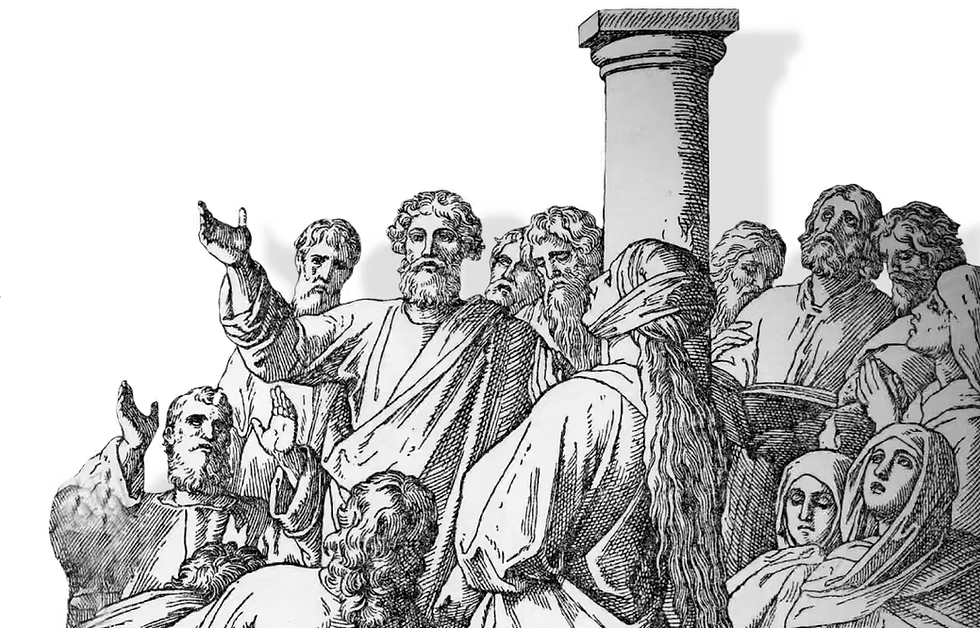The Chapel of the Apparition - Live Tour
Location – Church of the Holy Sepulcher
Map Coordinates - 31.778460, 35.229556
The Chapel of the Apparition a room that is about 1000 years old, and it’s in the custody of the Franciscan Catholics in Jerusalem. In this chapel is a column of stone believed by many to be part of the pillar to which Jesus was tied as He was whipped by the Roman soldiers.
Why is it called the Chapel of the Apparition? It’s because there is a belief among the Catholic Church in Jerusalem that, shortly after His resurrection, Jesus appeared to His mother, Mary, close to this very spot.
The Stations of the Cross Sculpture.
On the far side of this room is a bronze statue on the wall, showing all fourteen stations of the cross – all the way from the point at which Jesus was condemned by Pontius Pilate to die, to the tomb where He was buried, and from which He rose from the dead.

The Sculpture of Jesus Appearing to his Mother
On the front left side of the church there is a sculpture showing Jesus appearing to His mother shortly after His resurrection. This appearance of Jesus to his mother is not recorded in the Bible. It’s a legend that was first mentioned in a third-century book called “The Resurrection of Christ by Bartholomew the Apostle” (Fol. 6b-8b.) We know from the Bible that after Jesus rose from the dead He made several appearances to many different people, and there is really no reason to doubt that He also appeared to His mother, even though it’s not recorded in Scripture.


The Scourging Column - Scripture Reference - John 9:1
Here we have a blood-red stone column, made from an igneous rock called porphyry. According to the Franciscans, this column is the one against which Jesus was whipped by the Roman soldiers just before He was crucified.
The Story of the Scourging Column.
Jesus died around the year 30 AD. Forty years later in 70 A.D. the city of Jerusalem was destroyed by the Romans. It is believed that the Christians in this city went sifting through the rubble, searching for relics that were relevant to the life or death of Christ. It had only been 40 years since His death, and it’s likely that many Christians remembered the events surrounding His passion, so they knew where to look, and that’s probably when they found this column.
They brought this column, which back then was much taller than it is right now, to the Upper Room on Mount Zion, which was just outside the city walls of Jerusalem.
The Upper Room, where Jesus had His last Supper, is considered to be the world’s first church, because this is where the Apostles had their headquarters in Jerusalem. That’s why the Upper Room later became known as The Church of the Apostles.

The early disciples in the Upper Room with the Scourging Column
This column was kept in this room for fourteen centuries. There is an ample amount of proof for this claim. There are at least five ancient documents which tell us that this column was not only in the Upper Room, but that it was even tall enough to hold up the roof of this room.
In 333 A.D. there was an anonymous pilgrim from Bordeaux, France who claims that he saw this column in the Upper Room. (Source: The Bordeaux Pilgrim, Itinerarium Burdigalense.)
Fifty years later this column was seen again in the Church of Zion by a lady pilgrim from Spain, named Egeria. (Source: The Pilgrimage of Egeria, 66:7[b]).
In 390 AD Saint Jerome wrote about this column, indicating that it was tall enough to hold up the roof of the portico of the Church of Zion. (Source: Letter CVIII to Eustochium, 9, circa 390A.D.). That means that this column must have been much taller than it is now.
We even have an ancient diagram that was drawn shortly after 670 A.D., showing us that this scourging post was positioned in the very center of the Upper Room. (Source: De Locus Sanctus, The Pilgrimage of Arculfus, 670A.D.)
The Upper Room was controlled by the Franciscans up until 1524 A.D. In that year, when the Turkish Ottoman Empire took control of the Holy Land, this room was converted into an Islamic mosque, and the Catholics were not allowed to come here.
The Muslims, who now controlled this room, broke this column apart. Some of the parts of the column were lost, but most of it was salvaged by the man who, at that time, was in charge of the Catholic church in the Holy Land. His name was Father Custos Boniface of Ragusa.
What happened to this column?
29 years after the column was broken, in the year 1553 A.D. Father Boniface brought this particular piece of the column to the Chapel of the Apparition, and it’s been here ever since. From that day, people from all over the world have been coming here to pray, to meditate, and to contemplate Christ’s sufferings.
The red color of this stone is a grim reminder that Jesus’ body was once pressed up against it, and that fresh drops of His blood dribbled down its sides. This was the way that He was willing to die, so that He could purchase eternal salvation for every person in the world who becomes one of His disciples.
